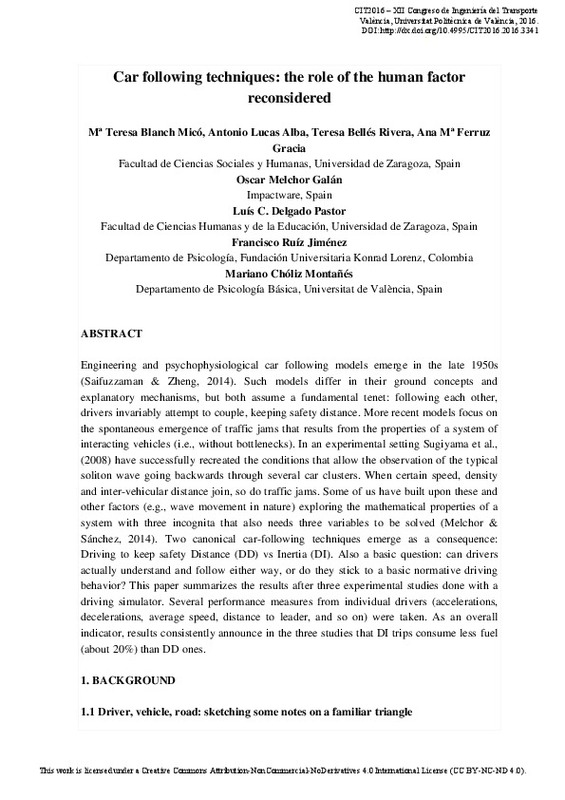JavaScript is disabled for your browser. Some features of this site may not work without it.
Buscar en RiuNet
Listar
Mi cuenta
Estadísticas
Ayuda RiuNet
Admin. UPV
CAR FOLLOWING TECHNIQUES: THE ROLE OF THE HUMAN FACTOR RECONSIDERED
Mostrar el registro sencillo del ítem
Ficheros en el ítem
| dc.contributor.author | Blanch Micó, María Teresa
|
es_ES |
| dc.contributor.author | Lucas Alba, Antonio
|
es_ES |
| dc.contributor.author | Bellés Rivera, Teresa
|
es_ES |
| dc.contributor.author | Ferruz Gracia, Ana Mª
|
es_ES |
| dc.contributor.author | Melchor-Galán, Óscar
|
es_ES |
| dc.contributor.author | Delgado Pastor, Luis
|
es_ES |
| dc.contributor.author | Ruíz Jimenez, Francisco
|
es_ES |
| dc.contributor.author | Chóliz Montañés, Mariano
|
es_ES |
| dc.date.accessioned | 2017-11-03T10:18:38Z | |
| dc.date.available | 2017-11-03T10:18:38Z | |
| dc.date.issued | 2016-06-01 | |
| dc.identifier.isbn | 9788460899600 | |
| dc.identifier.uri | http://hdl.handle.net/10251/90380 | |
| dc.description.abstract | [EN] Engineering and psychophysiological car following models emerge in the late 1950s (Saifuzzaman & Zheng, 2014). Such models differ in their ground concepts and explanatory mechanisms, but both assume a fundamental tenet: following each other, drivers invariably attempt to couple, keeping safety distance. More recent models focus on the spontaneous emergence of traffic jams that results from the properties of a system of interacting vehicles (i.e., without bottlenecks). In an experimental setting Sugiyama et al., (2008) have successfully recreated the conditions that allow the observation of the typical soliton wave going backwards through several car clusters. When certain speed, density and inter-vehicular distance join, so do traffic jams. Some of us have built upon these and other factors (e.g., wave movement in nature) exploring the mathematical properties of a system with three incognita that also needs three variables to be solved (Melchor & Sánchez, 2014). Two canonical car-following techniques emerge as a consequence: Driving to keep safety Distance (DD) vs Inertia (DI). Also a basic question: can drivers actually understand and follow either way, or do they stick to a basic normative driving behavior? This paper summarizes the results after three experimental studies done with a driving simulator. Several performance measures from individual drivers (accelerations, decelerations, average speed, distance to leader, and so on) were taken. As an overall indicator, results consistently announce in the three studies that DI trips consume less fuel (about 20%) than DD ones. | es_ES |
| dc.format.extent | 8 | es_ES |
| dc.language | Inglés | es_ES |
| dc.publisher | Editorial Universitat Politècnica de València | es_ES |
| dc.relation.ispartof | XII Congreso de ingeniería del transporte. 7, 8 y 9 de Junio, Valencia (España) | es_ES |
| dc.rights | Reconocimiento - No comercial - Sin obra derivada (by-nc-nd) | es_ES |
| dc.subject | Car following | es_ES |
| dc.subject | Normative driver behavior | es_ES |
| dc.subject | Behavioral models | es_ES |
| dc.title | CAR FOLLOWING TECHNIQUES: THE ROLE OF THE HUMAN FACTOR RECONSIDERED | es_ES |
| dc.type | Capítulo de libro | es_ES |
| dc.type | Comunicación en congreso | es_ES |
| dc.identifier.doi | 10.4995/CIT2016.2015.3341 | |
| dc.rights.accessRights | Abierto | es_ES |
| dc.description.bibliographicCitation | Blanch Micó, MT.; Lucas Alba, A.; Bellés Rivera, T.; Ferruz Gracia, AM.; Melchor-Galán, Ó.; Delgado Pastor, L.; Ruíz Jimenez, F.... (2016). CAR FOLLOWING TECHNIQUES: THE ROLE OF THE HUMAN FACTOR RECONSIDERED. En XII Congreso de ingeniería del transporte. 7, 8 y 9 de Junio, Valencia (España). Editorial Universitat Politècnica de València. 851-858. https://doi.org/10.4995/CIT2016.2015.3341 | es_ES |
| dc.description.accrualMethod | OCS | es_ES |
| dc.relation.conferencename | CIT2016. Congreso de Ingeniería del Transporte | es_ES |
| dc.relation.conferencedate | June 07-09,2016 | es_ES |
| dc.relation.conferenceplace | Valencia, Spain | es_ES |
| dc.relation.publisherversion | http://ocs.editorial.upv.es/index.php/CIT/CIT2016/paper/view/3341 | es_ES |
| dc.description.upvformatpinicio | 851 | es_ES |
| dc.description.upvformatpfin | 858 | es_ES |
| dc.type.version | info:eu-repo/semantics/publishedVersion | es_ES |
| dc.relation.pasarela | OCS\3341 | es_ES |








